Recent Articles
Popular Makes
Body Types
2020 Chevrolet Corvette C8 Road Test and Review

2020 Chevrolet Corvette front three quarter ・ Photo by Ron Sessions
Undeniably, the 2020 Chevrolet Corvette Stingray represents the most significant update to General Motors’ two-seat sports car in its storied 67-year history, arguably more comprehensive than the introduction of the first small-block V8 car in 1955 or the move from the first-gen roadster to the sleek, independent rear-suspension Stingray fastback coupe in 1963. The switch from the time-honored front-engine configuration to a new mid-engine layout changes everything.
Yet the 2020 Corvette Stingray coupe — endowed with its intoxicating-sounding, near-500-horsepower midships small-block V8 — remains the people’s exotic with a stunningly accessible $59,995 base price.
Speed Dating the C8
Limit-handling and race-track evaluations of production 2020 Corvettes — known as the C8 because it's the model's eighth generation — are still some months away, but a recent 90-minute street drive afforded me the opportunity to dip a toe in the C8 waters behind the wheel of a Z51-equipped early-build production Stingray coupe. The drive was limited to residential streets and (mostly) suburban speed limits with a Corvette engineer riding shotgun.
The first impression you’ll get when you roll in one of these babies is how accessible the new Corvette C8’s performance is. Despite its first-ever mid-engine layout, the new C8 is, after all, a Corvette, not a super-exotic, six-figure, ultra-low-volume toy that requires a secret handshake even to start up and drive to a local Cars and Coffee event. We didn’t have the chance to remove the targa top, but with it in place, the new C8’s body structure felt reassuringly stiff with no squeaks or rattles over a variety of road surfaces. The new car’s electrically boosted steering, quicker than in the previous-gen 'Vette, has a very direct feel due to the short, stiff column and — in the default Tour driving mode — light effort that doesn’t get tiring on a longer drive. Even with the large cross-section Michelin Pilot Sport 4S summer tires on the tested car, the C8’s steering was never darty and was unaffected by back-country high-crown roads with a fair amount of camber change.

Photo by Ron Sessions
Animated Suspension
As this is GM’s first mid-engine car since the ill-fated 1984-88 Pontiac Fiero, engineers built a fair amount of understeer into the C8’s suspension tuning to help mitigate the C8’s rearward weight bias and the specter of an unexperienced driver swapping ends by lifting throttle or braking hard mid-corner. It is likely, however, that higher-performance specialty versions of the C8 — which we expect to hit the market within a few years — will offer more neutral handling that allows experienced drivers to flick and catch the tail on command.
Beefy Brembo brakes (with monoblock calipers front and rear in the Z51) at all four corners offer tremendous stopping power and the C8’s new electronic brake booster delivers crisp, zero-lag, top-of-pedal response. The optional magnetorheological shocks — which can change their viscosity in microseconds in response to road inputs and are available only with the Z51 package — give the new C8 great vertical motion control and help make it such a joy to drive in everyday use. Despite ultra-low-profile run-flat tires, ride quality and impact harshness levels are luxury-sedan-worthy when tooling around in Tour mode.
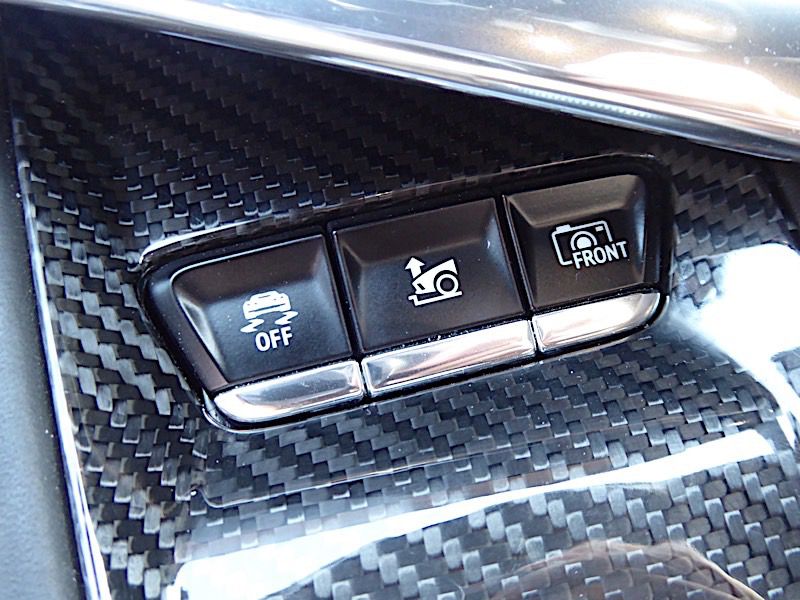
Photo by Ron Sessions
Shock and Awe
A comforting constant to the Corvette faithful is the gutsy rumble of a Chevrolet small-block V8, now emanating from behind the driver instead of in front. As the chugga-chugga of the big V-Twin defines the Harley Hog, you could say the time-honored two-valves-per-cylinder pushrod V8 is the glue that ties this near-exotic C8 to 65 years or so of Corvette lore — except this one is available for viewing under the rear hatch glass in all of its glory.
Frankly, the naturally aspirated 6.2-liter V8 feels stronger than its 495-horsepower advertised rating might suggest. In the Z51-optioned test car, that's partly due to shorter final-drive gearing and quick shifts from Chevy’s first-ever dual-clutch automatic, an eight-speed Tremec with steering-wheel-mounted paddle shifters. Sixty mph arrives from rest before you can say "one Mississippi, two Mississippi, three Mississippi" (a reported 2.8 seconds). Other big factors here are the rearward weight bias and meaty 305/30ZR20 Michelin Pilot Sports at the rear axle and launch control. Making it all sound like a "Fast and the Furious" soundtrack is the dual-mode exhaust, also included in the Z51 package, that goes into low-restriction mode at wider throttle openings.
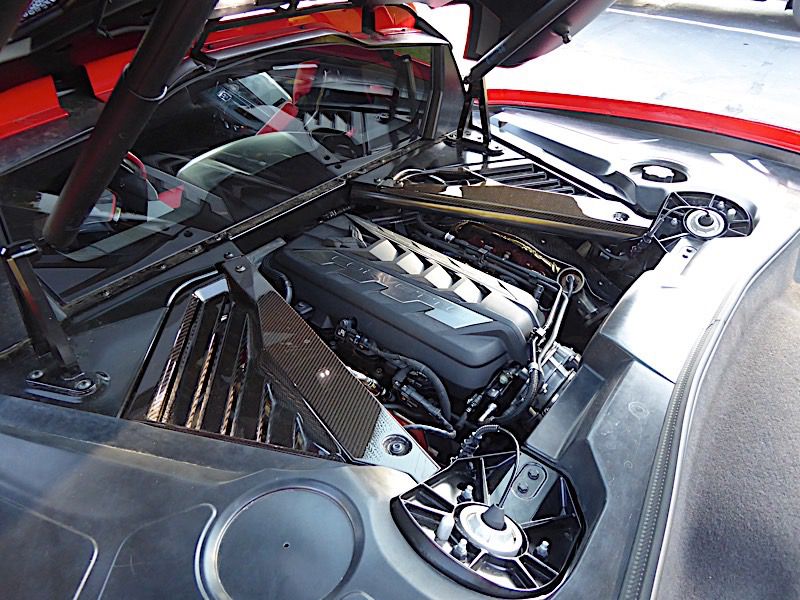
Photo by Ron Sessions
Control Central
There’s plenty of room for a 6-foot-plus driver to stretch out and get comfortable behind the controls. Aside from the push-button gear control on the console — new to GM but found in an increasing number of vehicles today — the control interfaces are pretty familiar. You’re sitting 16.5 inches closer to the front of the car in a cab-forward layout. The cockpit is enveloping with the infotainment screen angled toward the driver and the climate controls set atop a long, thin panel that subdivides the driver and passenger areas. The instrument panel is low, thanks to ultra-thin upper climate-control vents, and together with slim windshield A-pillars and free-standing outside mirrors affords the driver good forward visibility.
The fancy, stitched-leather handrest to the right of the push-button shifter houses the drive mode control wheel. Choose among (which is the baseline or "comfort" mode and just fine for everyday errands and cruising), Weather, Sport, Track, customizable MyMode, and Z mode. The latter is activated by the “Z” (for Zora as in the Corvette’s legendary chief engineer, Zora Arkus Duntov) button on the steering wheel and allows the driver to further customize MyMode engine and transmission settings for one key cycle. Sorry, no Eco mode for this car.
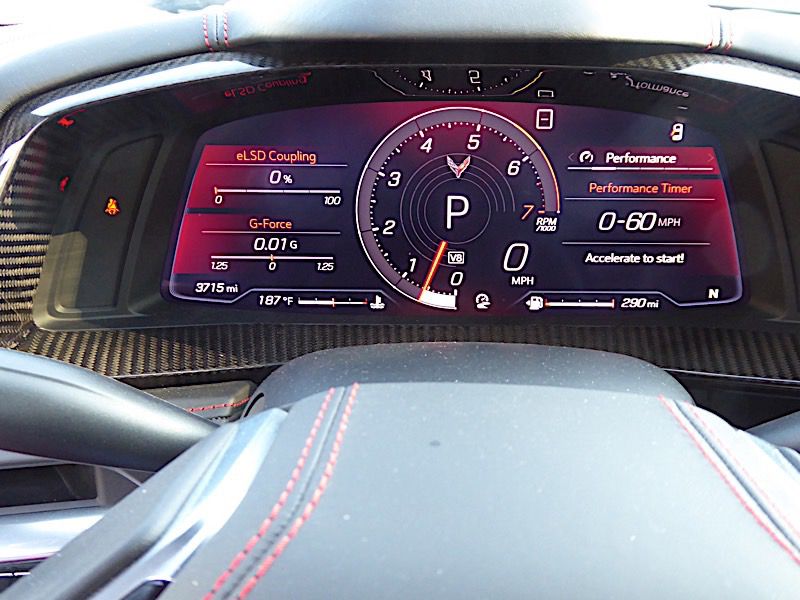
Photo by Ron Sessions
Performance Perches
The test car was equipped with the more generously bolstered GT2 seats that are included with the 3LT trim level. The GT2 seats have a racecar look but contain dual-density foam for comfort on long-distance drives as well as adjustable lateral wings and lumbar support, plus heating and cooling. These are also covered with softer Nappa leather and feature carbon-fiber trim. All seats have extra-long travel to accommodate a variety of physiques and considerably greater recline angle than was available in the last-generation car.
Passenger space, on the other hand, is less generous — particularly with elbow room, where larger passengers may feel a bit cramped on armrest size. The passenger also lacks convenient access to the infotainment screen and front cup holders, which are located on the driver side of the cabin divider/cubicle wall.
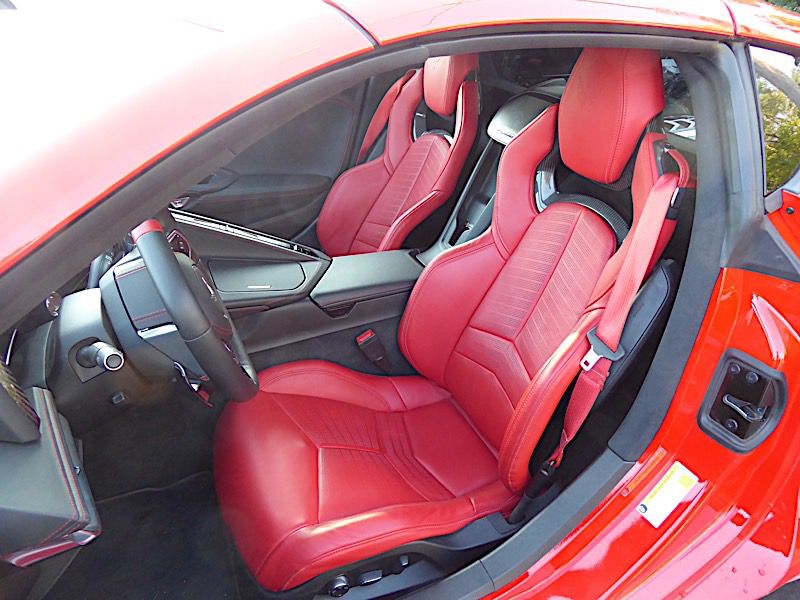
Photo by Ron Sessions
Pick a View
One of the more interesting features of the 2020 Corvette is its front curb-view camera that comes with the 2LT trim. In addition to selectable normal and wide-angle rear views, the driver can see where that low, pointy nose is in relation to a parking lot curb or other obstruction. Then, if the car is equipped with the optional front suspension lift system (as my test car was), the driver can push a console button and raise the nose about 2 inches. It's handy for negotiating steep driveway ramps or pesky speed bumps.
The one feature the Corvette’s camera system does not have is a 360-degree overhead view — yet.
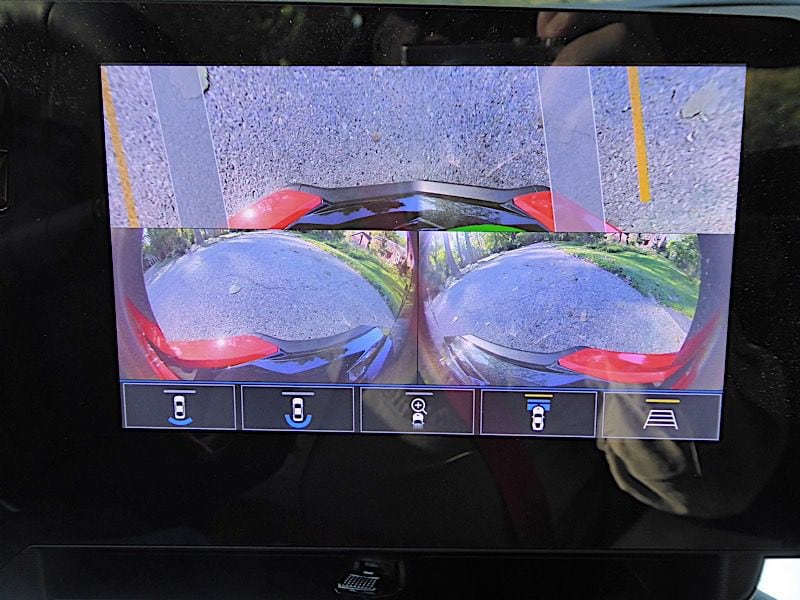
Rear Stowage
Opening up the rear hatch to take a better look at the Corvette’s enticing small-block V8 also gives access to the rear luggage compartment.
Rectangular in shape and with 7.2 cubic feet of capacity, the rear trunk is short but fairly deep and as wide as the car. The space will accommodate a pair of airplane roller bags, or two golf bags, or the targa top. The top locks into latches in the rear trunk to keep it in place and avoid rattling around on bumpy roads. The rear trunk is insulated to help deal with heat from the engine, transmission, and exhaust, but I wouldn’t stash any Halloween candy back there.
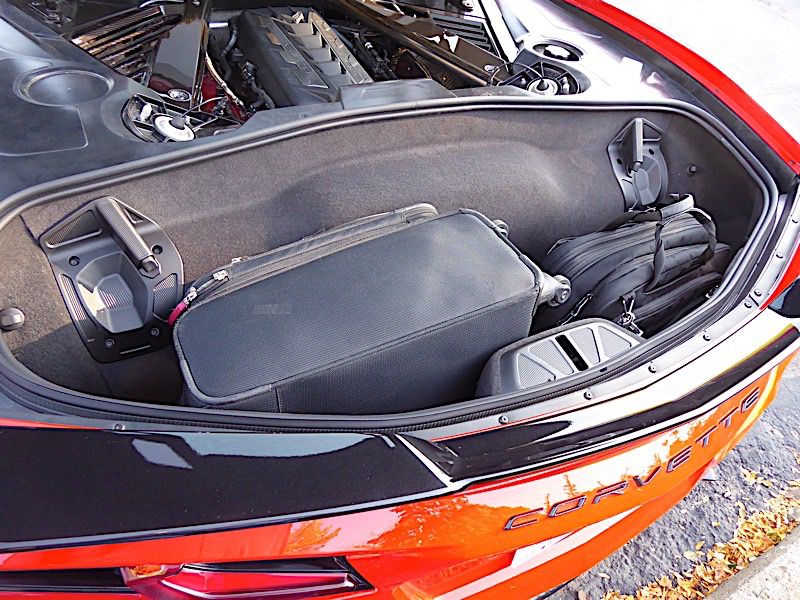
Photo by Ron Sessions
Front Stowage
Not altogether unlike the Porsche Boxster and Cayman, the 2020 Corvette Stingray has a second, smaller trunk in the front. It’s a deep, squarish 5-cubic-foot space suitable for carrying one standard-issue airplane roller bag — as shown here — with a small bit of extra room on top for a laptop bag as well. Or it’s the perfect size to carry some shopping bags full of whatever you buy when driving a mid-engine near-exotic.
The nice thing about this space is it’s away from engine heat. It’s also the only luggage space you’ll have if you’ve stowed the targa roof or stashed some golf bags in the larger rear trunk.
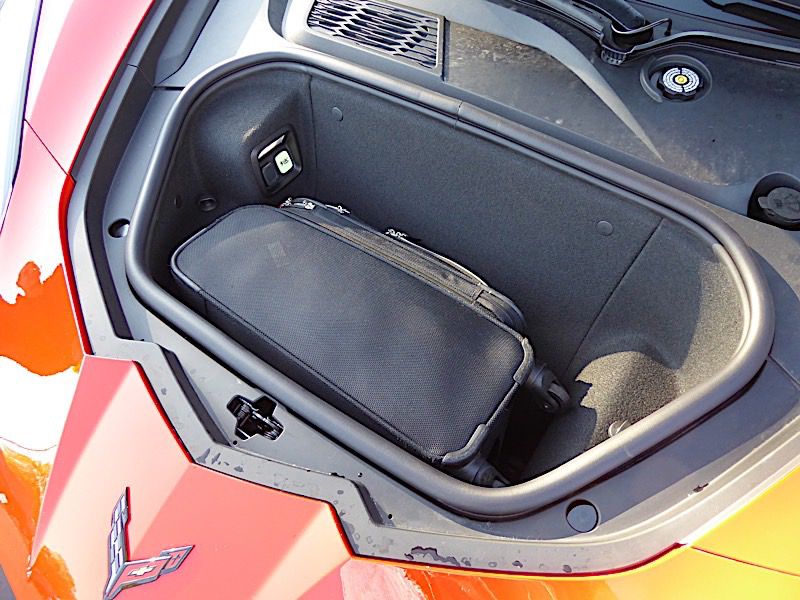
Photo by Ron Sessions
Driver-Assistance Tech
Sure, the 2020 Corvette Stingray has the beans to put just about every other car on the road behind it, but what’s behind you really does matter. Opting up to at least 2LT trim is kind of a must with this car, as it includes blind-spot and rear cross-traffic monitoring. If you drive this car in the city, you’ll appreciate the extra set of “eyes” back there. And as the 2020 Corvette has been highly anticipated, be prepared for gawkers who want to zoom in for a closer look at the mid-engine car.
Cruise control is standard, but no smart cruise control system that allows the driver to set both the cruising speed and minimum following distance to the traffic ahead is available. Although nothing’s been announced, the new Corvette will probably skip the smart cruise control step and go straight to a version of GM’s advanced semi-autonomous Super Cruise system that debuted in the 2018 Cadillac CT6. Or maybe you’d just rather drive the new C8 yourself with no assists.
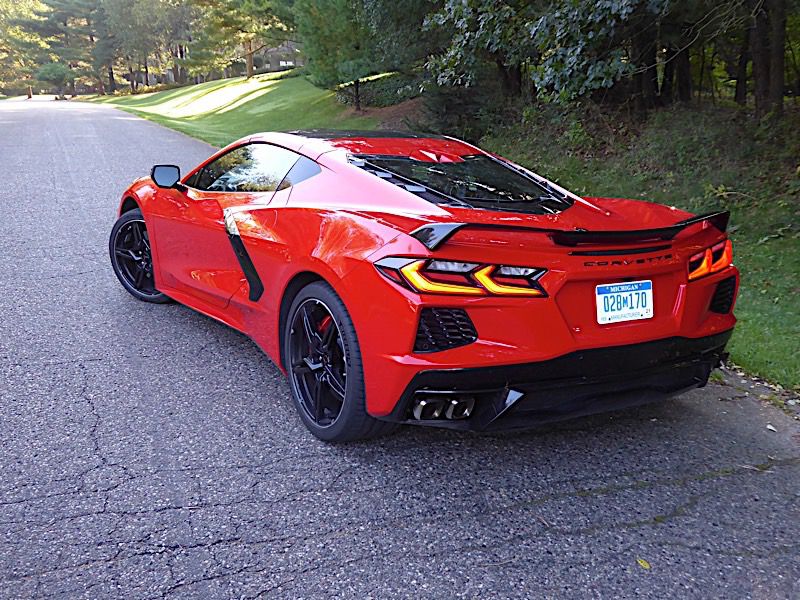
Photo by Ron Sessions
Buckle Up
Chevrolet is careful to label the 2020 Stingray coupe the fastest, most powerful “entry” Corvette ever. That certainly begs the question, what’s coming next? A retractable-roof convertible due out later in the 2020 model year has already been shown. And rumors keep bubbling up about engine variants with twin turbos, flat-plane crankshafts, overhead cams and hybrid versions down the road, some with as much as 850 horsepower that may easily double the base C8’s $59,995 base price.
All this means the Z51 version of the “base Corvette” with “only” 495 horsepower and the ability to squirt from rest to 60 mph in 2.8 seconds or so is just the beginning. Bring your wallet and your helmet.
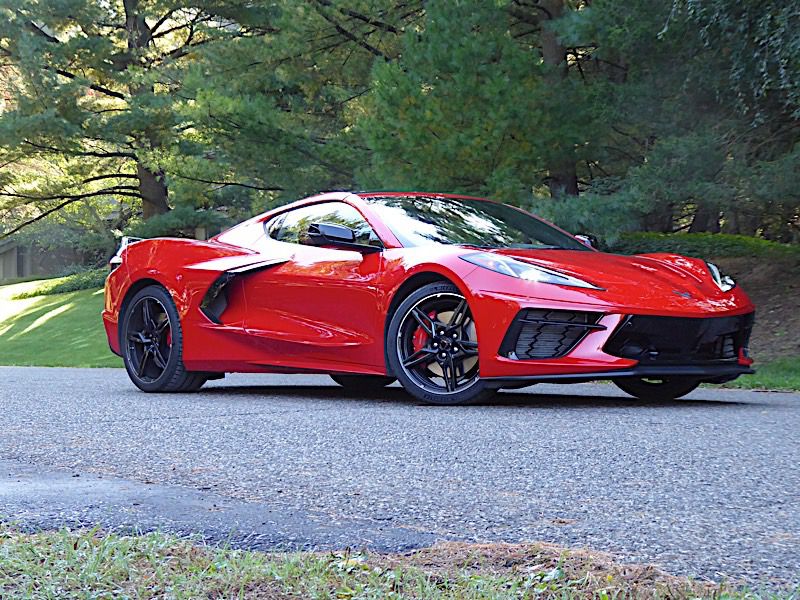
Photo by Ron Sessions